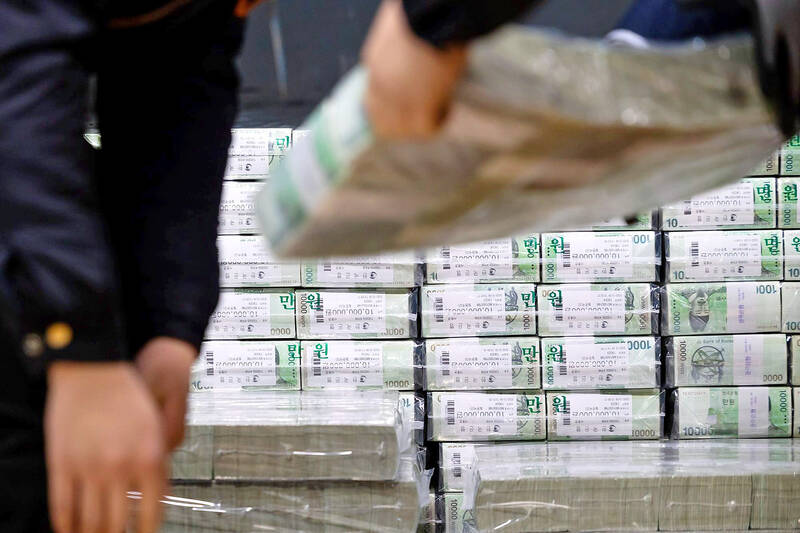The South Korean won’s near 17 percent rally since late October last year may be reaching its final stages as signs of a weaker economic outlook contrast with optimism over other emerging-market peers.
Falling demand for semiconductors is set to weigh on exports at a time when alarm bells are sounding about South Korea losing a global chip war.
The focus is to be on fourth-quarter growth data due on Thursday after the Bank of Korea governor suggested last week that economic concerns are surfacing, raising speculation the tightening cycle is winding down.

Photo: Bloomberg
Along with other headwinds such as the current account deficit and technical factors, this does not leave much scope for the won to gain and primes investors for a potential shift to other currencies such as the Thai baht. The South Korean currency was the best performer in Asia in the fourth quarter of last year.
While the currency might benefit from the Chinese economy picking up, sluggish exports are expected to drag on the won, ING Bank NV economist Min Joo Kang said.
“For the near term, probably appreciation elements will drive a stronger USD/KRW,” she added.
In addition, Min expects South Korea to post a current-account gap this quarter, putting more pressure on the won.
ING sees the won ending the quarter at 1,230 versus the US dollar, compared with 1,235.55 on Friday.
The won has strengthened, along with emerging-market peers, from late October on signs the US Federal Reserve may be nearing its terminal rate with inflation slowing.
Rising equity inflows amid improving risk sentiment aided by China’s re-opening also helped.
However, South Korea is struggling with a property-market downturn, and other positives for the won may be fading as Bank of Korea seems to have either reached, or be nearing the end of its rate hike cycle.
“There is room for more won strength during the remainder of the first quarter, but given how fast the currency has gained recently, the scope of the rally won’t be too big,” said SK Securities Co economist An Young-jin, who sees USD/KRW at 1,220 at the end of March.

Taiwanese suppliers to Taiwan Semiconductor Manufacturing Co. (TSMC, 台積電) are expected to follow the contract chipmaker’s step to invest in the US, but their relocation may be seven to eight years away, Minister of Economic Affairs J.W. Kuo (郭智輝) said yesterday. When asked by opposition Chinese Nationalist Party (KMT) Legislator Niu Hsu-ting (牛煦庭) in the legislature about growing concerns that TSMC’s huge investments in the US will prompt its suppliers to follow suit, Kuo said based on the chipmaker’s current limited production volume, it is unlikely to lead its supply chain to go there for now. “Unless TSMC completes its planned six

Intel Corp has named Tasha Chuang (莊蓓瑜) to lead Intel Taiwan in a bid to reinforce relations between the company and its Taiwanese partners. The appointment of Chuang as general manager for Intel Taiwan takes effect on Thursday, the firm said in a statement yesterday. Chuang is to lead her team in Taiwan to pursue product development and sales growth in an effort to reinforce the company’s ties with its partners and clients, Intel said. Chuang was previously in charge of managing Intel’s ties with leading Taiwanese PC brand Asustek Computer Inc (華碩), which included helping Asustek strengthen its global businesses, the company

Power supply and electronic components maker Delta Electronics Inc (台達電) yesterday said second-quarter revenue is expected to surpass the first quarter, which rose 30 percent year-on-year to NT$118.92 billion (US$3.71 billion). Revenue this quarter is likely to grow, as US clients have front-loaded orders ahead of US President Donald Trump’s planned tariffs on Taiwanese goods, Delta chairman Ping Cheng (鄭平) said at an earnings conference in Taipei, referring to the 90-day pause in tariff implementation Trump announced on April 9. While situations in the third and fourth quarters remain unclear, “We will not halt our long-term deployments and do not plan to

The New Taiwan dollar and Taiwanese stocks surged on signs that trade tensions between the world’s top two economies might start easing and as US tech earnings boosted the outlook of the nation’s semiconductor exports. The NT dollar strengthened as much as 3.8 percent versus the US dollar to 30.815, the biggest intraday gain since January 2011, closing at NT$31.064. The benchmark TAIEX jumped 2.73 percent to outperform the region’s equity gauges. Outlook for global trade improved after China said it is assessing possible trade talks with the US, providing a boost for the nation’s currency and shares. As the NT dollar